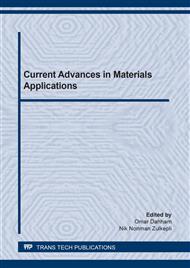[1]
J. Xu, G. Liang, L. Wang, W. Xu, W. Cui, H. Zhang, Z. Li, DFT Studies on the electronic structures of indoline dyes for dye-sensitized solar cells, J. Serb. Chem. Soc. 75 (2) (2010) 259-269.
DOI: 10.2298/jsc1002259x
Google Scholar
[2]
H. Sadkia, M. N. Bennania, M. Hamidib, M. Bouachrine, New materials based on diketo-pyrrolo-pyrrole for Solar cells application, J. Mater. Environ. Sci. 5 (S1) (2014) 2156-2162.
Google Scholar
[3]
F. A. AL-Temimei, A. S. Alaboodi1, Design and Study of Electronic Structural and Corrosion Inhibitory Action of New π-Conjugated Materials for Medical and Solar Cells Applications, Indian Journal of Forensic Medicine & Toxicology, 13 (4) (2019) 908-914.
DOI: 10.5958/0973-9130.2019.00413.4
Google Scholar
[4]
M. Hachi, S. El Khattabi, A. Fitri, A.T. Benjelloun, M. Benzakour, M. Mcharfi1, M. Hamidi, M. Bouachrine, DFT and TD-DFT studies of the π -bridge influence on the photovoltaic properties of dyes based on thieno[2,3-b]indole,, J. Mater. Environ. Sci., 9 (4) (2018)1200-1211.
DOI: 10.1007/s11164-018-3674-8
Google Scholar
[5]
K. D. Seo, H. M. Song, M. J. Lee, M. Pastore, C. Anselmi, F. D. Angelis, M. K. Nazeeruddin, M. Gräetzel, H. K. Kim, Coumarin dyes containing low-band-gap chromophores for dye-sensitised solar cells, Dyes and Pigments, 90 (2011) 304-310.
DOI: 10.1016/j.dyepig.2011.01.009
Google Scholar
[6]
M. Bouachrine, S. M. Bouzzine, M. Hamidi,, J. P. Lere Porte, F. Serein-Spirau, J. M. Sotiropoulos, K. Miqueu, Molecular Design of New π-Conjugated Materials Based on Thiadiazolothienopyazine for Organic Solar Cells, J. Mater. Environ. Sci. 1 (2) (2010) 78-83.
DOI: 10.1016/j.jscs.2013.01.003
Google Scholar
[7]
F. A. Mohammed, H. I. Abbood, Electronic Structure of Vanadium Tetrachloride Di-Hydroxyl Metal Complex, Journal of Engineering and Applied Sciences, 13 (23) (2018) 9823-9830.
Google Scholar
[8]
W. Fan, D. Tan, Q. Zhang, H. Wang, Computational study of diketopyrrolopyrrole based organic dyes for dye sensitized solar cell applications, J. Mol. Graph. Model,57 (2015) 62-69.
DOI: 10.1016/j.jmgm.2015.01.006
Google Scholar
[9]
W. Koch, M. C. Holthausen, A Chemist's, Guide to Density Functional Theory, Second Edition, Wiley-VCH Verlag GmbH, Weinheim, (2001).
Google Scholar
[10]
R. G. Parr, W. Yang, Density-functional Theory of Atoms and Molecules" Oxford University Press, New York, (1989).
Google Scholar
[11]
K. L. Schuchardt, B. T. Didier, T. Elsethagen, L. Sun, V. Gurumoorthi, J. Chase Li, J. T. L. Windus, Basis Set Exchange: A Community Database for Computational Sciences, J. of Chemical Information and Modeling, 47 (2007) 1045-1052.
DOI: 10.1021/ci600510j
Google Scholar
[12]
C. A. Tsipis, DFT flavor of coordination chemistry, Coordination Chemistry Reviews, 272 (2014) 1-29.
DOI: 10.1016/j.ccr.2014.02.023
Google Scholar
[13]
R. T. Morrison, R. N. Boyd, Organic Chemistry, 6th Edition, New York University, (2007).
Google Scholar
[14]
M. Larif, T. Abram, L. Bejjit, M. Bouachrine, T. Lakhlifi, New materials based on imidazo [4,5-b]pyridine derivatives candidates for optoelectronic device applications: Theoretical investigations, Journal of Chemical and Pharmaceutical Research, 6(11) (2014) 410-419.
Google Scholar
[15]
R. Skonieczny, J. Makowiecki, B. Bursa, A. Krzykowski, M. Szybowicz, haracterization of titanyl phthalocyanine (TiOPc) thin films by microscopic and spectroscopic method, Spectrochimica Acta Part A: Molecular and Biomolecular Spectroscopy, 191 (2018) 203-210.
DOI: 10.1016/j.saa.2017.10.034
Google Scholar
[16]
F. A. AL-Temimei, A. H. O. ALkhyayatt, A DFT/TD-DFT Investigation on the Efficiency of New Dyes Based on Ethyl Red Dye as a Dye-Sensitized Solar Cell Light-Absorbing Material, Optic, 163920 (2019).
DOI: 10.1016/j.ijleo.2019.163920
Google Scholar
[17]
A. El Alamy, A. Amine, S. M. Bouzzine, M. Lachgar, M. Hamidi, A. Elhamzi, M. Bouachrine, DFT study of small compounds based on thiophene and benzo[1,2,5] thiadiazole for solar cells: correlation-structure/electronic properties, Journal of Materials and Environmental Sciences,.8(11) (2017) 3897-3905.
Google Scholar


